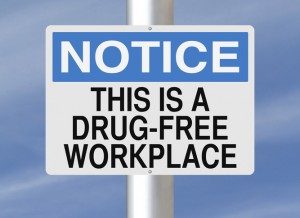Drug Free Workplace, Is That a Reality? (OR: Drug Testing, Can I, Should I?)
It’s summer time which means people are out having fun. And not all of it is safe and responsible. Did you know that an average of 9.5 percent of all workers from ages 18 to 64 were dependent upon or abused illicit drugs or alcohol in the past year?
You might think that number is really high, or possibly much lower than expected, but the truth of the matter is, at some point you are going to come face to face with the decision “To test, or not to test.” Do you know what to do? How to manage your risk as it relates to drugs and alcohol in the workplace?
As an employer you have an obligation to maintain a safe workplace. When employees report to work under the influence of drugs and/or alcohol, it puts everyone at risk.
When it comes to testing for alcohol and drugs, there are some things to remember:
• Make sure your drug and alcohol policy is up to date and easy to find in your employee handbook. Employees should have a clear understanding of the company’s expectations when it comes to drugs (illegal or prescribed), alcohol or other unauthorized substances.
• Include prescription drug use in your drug and alcohol policy. Specifically include details on notifying HR or a Supervisor about any medication that could affect their performance. In addition, there should also be a section that mentions prescription drugs being used outside of their specifications.
• For Oregon (and several other states), including language specifically addressing marijuana is important. Employees need to understand that even though the state has legalized medicinal and recreational use, it’s still illegal under federal law and they could lose their job for any use.
• Include language that sets forth clear testing policies. This should notify employees when testing is required, how testing is conducted, as well as the confidentiality of drug test results. Remember, because alcohol is legal and alcoholism is considered a disability under the ADA, testing for alcohol is a bit more limited than testing for illicit drugs. Employees should only be tested for alcohol if you believe they are currently under the influence of alcohol.
• Include language that encourages employees to come forward to seek help before it affects their performance or something more catastrophic.
• Train your management and supervisory staff how to recognize the signs and symptoms of impairment and what to do about it. This is all covered in Reasonable Suspicion training.
Summer is a great time to refresh your employees’ minds about your drug-free workplace policies and the importance of their safety.
• Make sure you are applying your policy and practice consistently, to avoid discrimination claims.
Maintaining a drug free workplace takes much more than just having a good policy and knowing when to test. Providing drug and alcohol prevention training for your employees to teach them of the dangers of drug and alcohol abuse can also have a positive effect in the workplace. In addition, having an Employee Assistance Plan (EAP) in place to help those who may request counseling or a referral for treatment, can be essential in those times of need.
Disclaimer: Articles featured on Oregon Report are the creation, responsibility and opinion of the authoring individual or organization which is featured at the top of every article.



